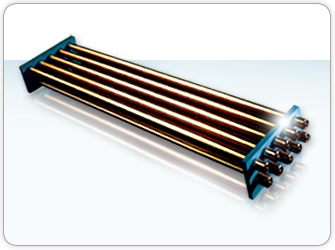WATER ENERGIZERS® TECHNICAL INFORMATION
 The Water Energizer® is a product that contains a precisely formulated core material encased in a tubular metal sheath that is sealed on both ends. A completely airtight seal is necessary to maintain the integrity and function of the core material. The purpose of the specific configuration is to produce a unit that can be considered to exhibit the attributes of a half-cell when immersed in an aqueous solution. The aqueous solution then acts as the other half-cell and completes the reaction.
The Water Energizer® is a product that contains a precisely formulated core material encased in a tubular metal sheath that is sealed on both ends. A completely airtight seal is necessary to maintain the integrity and function of the core material. The purpose of the specific configuration is to produce a unit that can be considered to exhibit the attributes of a half-cell when immersed in an aqueous solution. The aqueous solution then acts as the other half-cell and completes the reaction.
Unlike the normal functioning of a stand-alone cell that is designed to discharge large quantities of energy over a short period of time, this product is unique in that it is capable of discharging very small quantities of energy over long periods of time. The metal casing of the Water Energizer® is the agent of connectivity between the individual half-cell reactions. The sheath metal of the Water Energizer® does not react and therefore maintains its molecular integrity. The Water Energizer® is sealed and self-contained, and with mobile reaction of the enclosed materials, a reversible chemical reaction is achieved.
The functioning of the Water Energizer® is such that, when placed in a conducting solution, it will exhibit a positive voltage potential with the solution. In a laboratory environment, if a Water Energizer® is placed in a non-conducting aqueous solution contained in a non-conducting vessel, there will be no voltage potential between the Water Energizer® and the solution. However, when the aqueous solution is rendered conductive by adding small quantities of ions to the solution, a measurable positive voltage potential will be exhibited. The measurable voltage will increase as the concentrations of salts in the solution increases. Additionally, an increase in temperature in the above example will cause an increased voltage to be exhibited.
The half-cell reaction that generates a small voltage potential with the conducting aqueous solution results in a decrease in the free energy of the solution. This decrease in the free energy can be measured by the change in solution polarity and the change in the equilibrium constants of the dissolved solids.
When considering the effect of lowering the solution’s free energy, it should be understood that the solution consists of two components:
- Dissolved or soluble material
- Insoluble or crystalline materials
In both components, a negative change in the solution’s free energy will result in a polarization or “lining-up” of both crystalline materials and ions in solution. This change will affect the corrosion and scaling tendencies of the treated aqueous system.
When the free energy of an aqueous electrolyte is lowered by the proper placement and maintenance of the Water Energizer®, a disruption of the crystalline network of solids occurs. This results in the formation of a loose, sediment-like precipitate which does not adhere to metal surfaces and is easily flushed away during routine maintenance.
Corrosion is inhibited as the overall free energy of the system is lowered, and the reactions that cause corrosion are minimized. The Water Energizer® reduces the free energy of the system to the point that the activation energy required to initiate the corrosion process cannot be provided by the system.
In summary, the Water Energizer® generates an internal electric field which modifies the degree of polarization and energy content of the water and the substances dissolved in the water within the system. The increase in polarization modifies the physical-chemical properties of the system with a consequent decrease in energy content.
The Water Energizer® produces the following verifiable effects in aqueous solutions:
- Deformation of the crystalline network of dissolved salts
- Decrease of the interfacial tensions between solids
- Inhibition of corrosion
For additional technical information contact us at or by phone at 800.500.0771.

